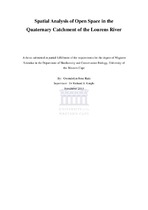| dc.description.abstract | This thesis looks at aspects relating to vegetated open space in the quaternary
catchment of the Lourens River, Cape Town, South Africa in 2005 and at GoogleEarth as a source of imagery for research. The research questions were: “Is
GoogleEarth a suitable source of imagery for spatial analysis of landscapes?”; “What was the potential access (proximity) to vegetated open space of at least 900 m2 in the Lourens River quaternary catchment in 2005?”; “How many vegetated open spaces with an area of at least 900 m2 were present in the Lourens River quaternary catchment in 2005?” and “What spaces within the urban edge in the Lourens River quaternary catchment can be said to have some protection from development?” Open space has multiple benefits for humans in terms of health and social interaction.In urban areas, it is also important for biodiversity conservation. In Cape Town, this is critical since the city has critically endangered national vegetation types that only occur within its boundaries and 319 IUCN Red List species within its boundaries.Proximity does not reflect use of open space which is affected by the size of the open space, quality of the open space, neighbourhood attributes and individual and collective perceptions of the open space. Quality of vegetated open space is dependent on its facilities and maintenance which are largely determined by its management. In Cape Town, open space management is mainly mowing/brush cutting all spaces which has a negative impact on biodiversity retention. Mowing is continued because of popular demand so action needs to be taken to change popular perceptions.Google Earth is readily available and widely used. It is used for research in diverse disciplines. Local Internet connection problems complicated this study. Alignment and projection problems were encountered in this study. Thus Google Earth geospatial issues make it a poor choice of imagery source for large scale spatial analysis of landscapes.Open space was digitized in Google Earth and transferred to a propriety GIS for editing. Vegetated spaces with a minimum of 900 m2 and a width of at least 15 m
were selected from the approximately 1025 digitised spaces. Google Earth imagery
was used because it is readily available. Euclidean distances of 300 m, 500 m, 800 m and 900 m (taken from literature) were used to buffer the digitized vegetated open spaces and other data on schools, train stations, bus routes and taxi routes in and within 900 m of the catchment. Buffer analysis was carried out. Data from the City of Cape Town and a schools layer were used to determine the number of cemeteries,community parks, nature reserves and school grounds – space regarded as having some protection from development - within the urban edge of the city and what area they covered.Within or partially within the Lourens River quaternary catchment, 593 vegetated open spaces of at least 900 m2 were identified. The analysis showed that only two houses were beyond 300 m from a vegetated open space. There was vegetated open space within 300 m of all the schools, stations, bus and taxi routes within the catchment and in close proximity to the catchment. Within the urban edge, only 124 spaces were found to be protected, of which only one was a nature reserve.Most of the open spaces are not formally designated as open space and are vulnerable to development. Much development has taken place since 2005 in the Lourens River quaternary catchment so action is needed to ensure proximity to vegetated open space remains a positive feature of the area.Expanding the present research to cover a larger area would provide additional baseline data. Further research could consider the loss of open space over time and the impact of management on the quality of designated open space. | en_US |

